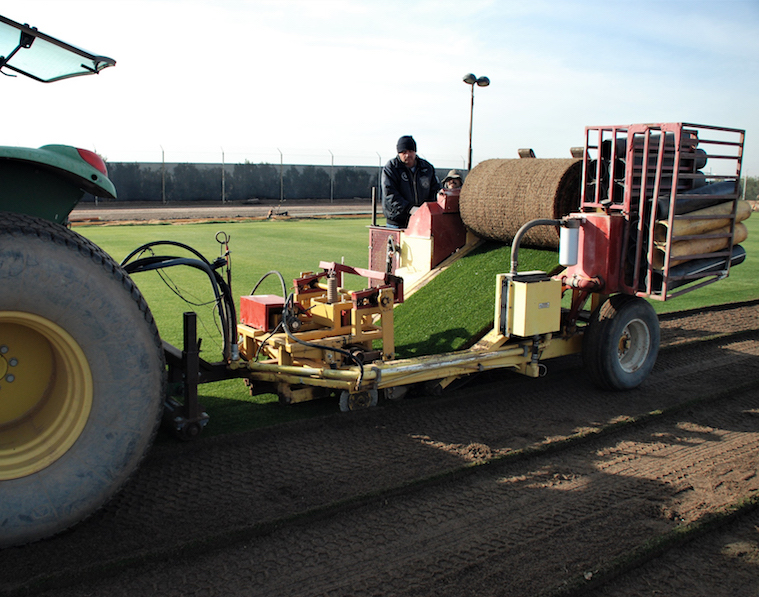By Suz Trusty
“In-season resodding is a partnership between the field manager and the sod producer,” said Tony Leonard, director of grounds for the Philadelphia Eagles. “They are as big a part of the field management at our stadium as anyone else. We trust them to provide us with a field that will be ready to play an NFL game. It’s not an easy thing to do. It takes a lot of investment, babysitting and care. The most important factor in doing it successfully is communication.”
That’s why the 2020 NFL Field Managers Symposium invited the eight sod farms that regularly produce sod for NFL teams in-season to participate in a round-table discussion earlier this year.* It was a two-hour, interactive session, teaming the sod producers with 125 field managers and staffers. Three members of the NFL Team Operations Department also attended.
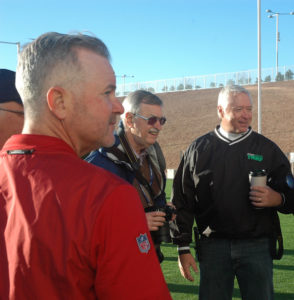
The eight sod farms and their attending representative were: James Betts for Tuckahoe Turf Farms, New Jersey; Chad Price for Carolina Green Corp., North Carolina; Jonathan Holland for Precision Turf, LLC, Georgia; Donald Thomas for Quality Sod, Florida; Jimmy Fox for Evergreen Turf, Arizona; Joe Wilkins for Green Valley Turf Co., Colorado; Greg Dunn for West Coast Turf, California; and Marty Schaafsma for Schaafsma Sod Farm, Illinois.
The field managers and sod producers covered a broad range of topics, including sod farm certification, on-field events, growing scheduling, harvesting and installation timing, transportation, scheduling and the most important factor –communication.
While each of the sod producers has developed their own proprietary product, and those products differ in the grass species and cultivars, and vary in production methods from grown on plastic to grown in the field, they all face similar issues and challenges, and all have the same objective – a safe, game-ready field that meets NFL expectations.
Two examples of successful field manager/sod producer partnerships are Tony Leonard (Eagles) and his warm-season ready-to-play field provider, Chad Price (Carolina Green Corp.); and Andy Levy, turf manager for the Arizona Cardinals, and his ready-to-play field supplier, Jimmy Fox (Evergreen Turf). Those four shared their takeaways from the symposium.
“The NFL home office doesn’t control the stadium managers or owners or the team logistics,” said Fox. “They set standards, but every team is responsible for their own field and their own field conditions. It’s up to the home team to determine the relationship they want to have with the sod producer. The NFL is trying to put the testing and guidelines in place, but that isn’t making a big impact on the team’s planning, or lack thereof. Communicating to the stadium managers and the team management is essential – we all need to be on the same page. During the symposium we were able to share how it can work when that happens, discussing the partnership we have with Andy and the Cardinals and that Tony has with Carolina Green and his cool-season ready-to-play grass provider, Tuckahoe Turf Farm.”
Added Price, “I think it was eye opening for the league to hear what happens at the farm in growing this specialty sod –how the process can work, where the concerns and liabilities are when planning a project, how much lead time do you need, how much time to produce the sod, and the logistics in harvesting, transporting and placing the product.”
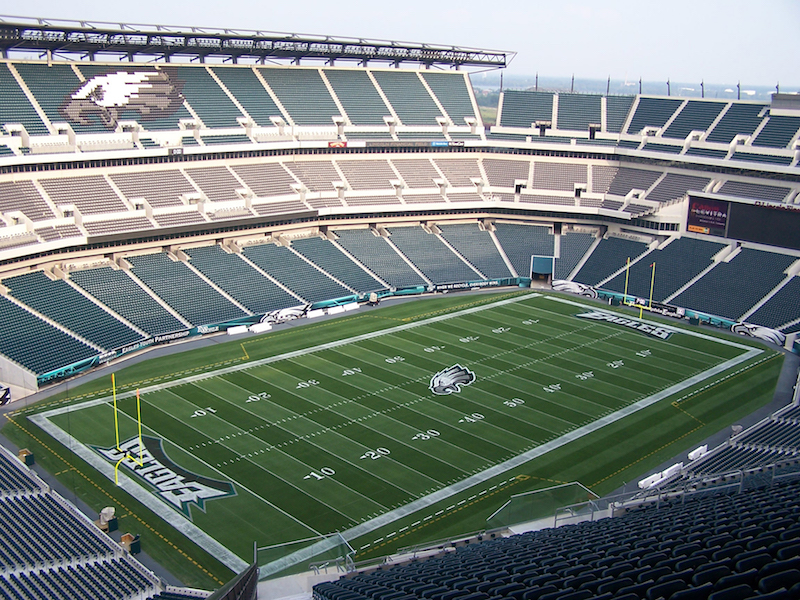
Demand for these fields
In-season sodding impacts nearly all the NFL field managers.
“Even the synthetic turf field managers have done it at some point if they have hosted international soccer in their stadium,” said Leonard. “Installing ready-to-play natural grass over synthetic turf has its own set of challenges with keeping newly laid natural grass sod alive indoors.”
The demand for ready-to-play fields now extends beyond the NFL.
“Every major stadium that has a concert wants this sod – Major League Baseball, Major League Soccer, top-tier universities,” said Fox.
Added Price, “It’s also in demand in the construction of new ballparks. Sometimes they don’t have a choice because of the construction schedule. For others, it’s a choice to buy time. If they use ready-to-play sod, they gain an extra month or two for construction. On a multi-million-dollar project, an extra $200,000 to sod the field is a tradeoff sort of like pennies on the dollar.”
Said Fox, “The NFL field managers understand the quality of the sod they require for the same week play is far higher than is needed for baseball or soccer. The expectations have changed, especially over the last five years. What the players expect is a shorter, denser, natural grass. That puts a lot of pressure on the grower; no thatch, no grain, no disease, fully mature – it has to be right on the day it goes down. The weight and speed of the NFL player is greater, and the way the football player connects with the grass is different. The NFL field needs an extra level of maturity and complexity, but everyone else thinks they need that product.”
The perception of many stadium managers and team owners is that sod growers will have a field that meets their expectations on the shelf, ready to go.
“That’s not the case,” said Fox. “Their stadium may book an extra concert and need an extra field to install right after it. But it takes us from 12 months to 24 months to have a field ready to go; the average is 18 months. So we’re planning that far out for how much grass we’ll need, where it will go, and when it will go.”
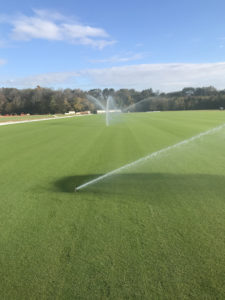
An extra concert and the need it creates for an extra field puts a lot of pressure on everyone. If the field manager does not have a contract and a good relationship with the sod producer, he could be scrambling to find one.
“The field manager needs to communicate that extra event as soon as he finds out about it,” said Fox. “For the sod producer, there’s a huge cost in carrying that inventory. It’s a business decision. It’s vital that management also understands what it takes, how long it takes, how important it is to have a relationship and contract that covers you not just for the playing season but for the concert season, too.”
The field manager must find another field after the concert. “But the sod producer may have to say my grass is not ready to go,” said Fox. “I hate to send you to anyone else, but I don’t have any other choice because I don’t want to send an inferior product. It may not hold together well for harvesting or installation, it may not be as dense or mature as needed and the players are slipping. If any of that happens, everyone wants to blame the sod producer for not sending the right product. We don’t want to make compromises on field quality. The field manager can’t afford to have that, and neither can the sod producer.”
Added Levy, “It’s in everybody’s best interest to have the best fields possible. When my guys go to Chicago or Carolina, I want them playing on a great field. The field portion of the NFL isn’t a competition – we’re all trying to make the fields as safe as they can be. As field managers, we’re looking at all the potential hazards, anything that might put our team and their team in jeopardy.
“That’s why the relationship between field managers is so important,” said Levy. “There’s such a unique body of knowledge within the NFL group of field managers, we can share hundreds of years of turf experience by working together. I can call Tony Leonard or Tom Vaughan (head groundskeeper for the Carolina Panthers) and so many others to ask what my players should expect when they go to play on their fields and know they’ll level with me, as I do with them. I’m confident that they and their staff and the sod grower they are working with are doing everything they can to ensure these fields are the safest they can be for the players.”
When someone has a rough game, it’s not about placing blame, noted Levy. “When one of us looks bad; we all look bad and we’ll all get asked about it,” he said. “I want to be able to explain that they did the best they could under the circumstances. Our goal is the safest fields possible, that’s why we get involved and communicate with our colleagues – we’re all working together.”
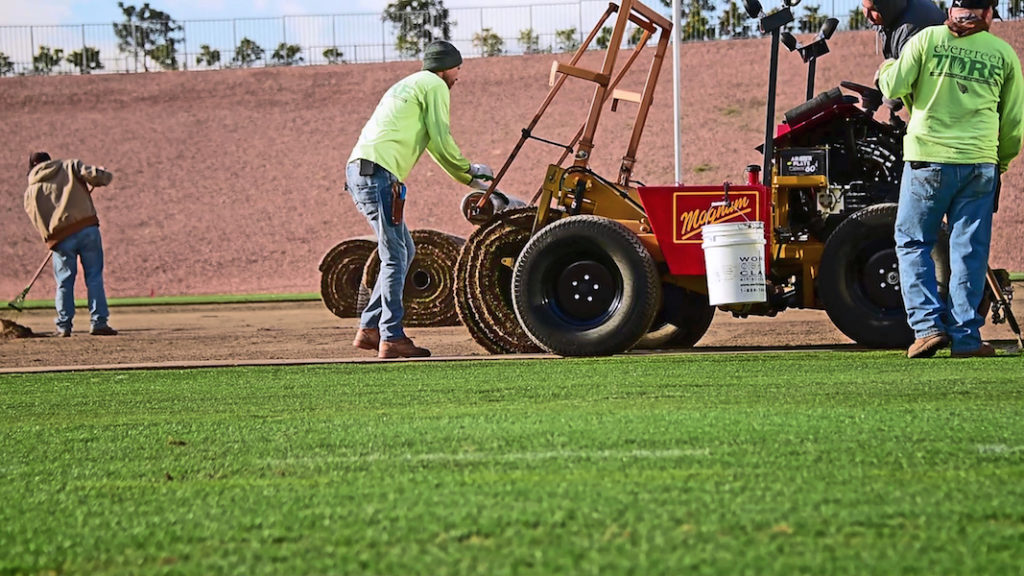
Communication – it’s your field away from home
The communication starts from day one. Growing grass to meet NFL standards for in-season resodding is a big investment for the sod grower. For the field manager, that’s his field and it’s going to be his field from the point of commitment until it’s installed in his stadium, whether that’s in six months or in two years.
“It’s your field away from home,” said Leonard. “So you go to see it, check how it’s doing, and coordinate its management program with the sod grower. Carolina Green, our bermudagrass grower, is a 10-hour drive away. About three times a year, I fly down to Charlotte to see the field, talk with Chad and his team, and review the schedule with them. Tuckahoe, our bluegrass grower, is about a half hour from us, so I’ll visit there more often, between seven and 10 times a year. Tuckahoe has multiple microclimates across their 700-acre farm, which impacts plant growth and thus harvest timing. We have it all planned in advance, but we’re dealing with natural grass – a living thing – so at both sod farms, every season varies with the changing weather patterns.”
Said Levy, “It takes open communication to grow a custom piece of grass. We need to have it financially covered when we commit to it. It’s vital that I be at the farm to have my input and have my maintenance practices used on the sod so that Jimmy is growing it just like we do it here in Glendale. I used to have the whole summer to manage my field for the start of the season. Now we’re the only team that holds our training camp on our game field. We resod immediately after it ends. So from week one of the season, I’m playing on Jimmy’s grass.”
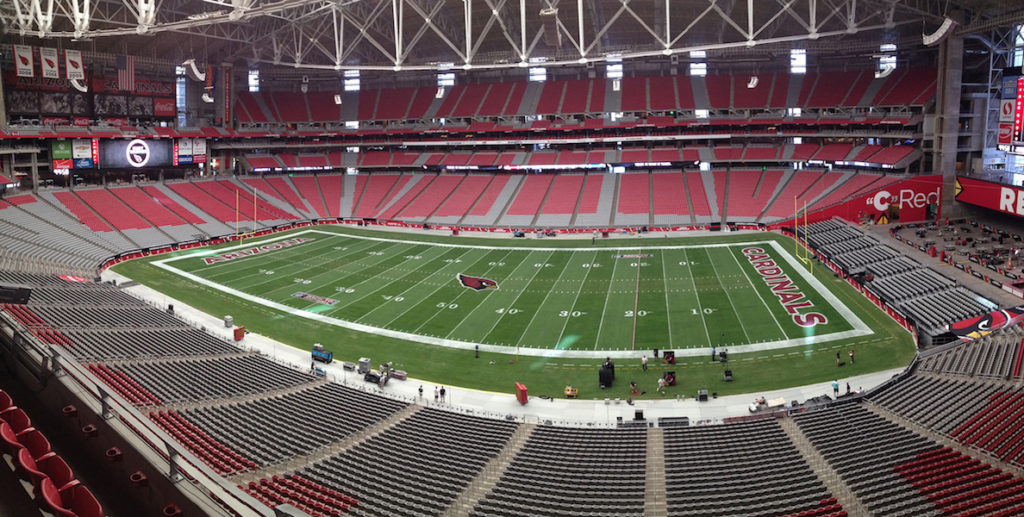
Trucking issues
Trucking is a major issue.
“It was important for the NFL head office to hear about that,” said Leonard. “Not all sod growers have their own trucks, and those that do probably don’t have enough trucks to run the sod all over the country. They need to have strong relationships with outside trucking companies, and even when they do, there is more demand for trucking than there are qualified truckers. And the new federal regulations make it even more challenging.” Price added, “Just changing the schedule by a couple days makes it hard to arrange up to 30 trucks to be delivered within a tight window.”
Because of the strong relationship between the field manager and the sod grower, both know the sod is healthy when it’s harvested.
“The big unknown for us is the transportation,” said Leonard. “The communication during that stage is vital. Once the sod is on that truck, it could be involved in an accident, or blow a tire, or the driver could get pulled over for a traffic-related issue or run into unexpected traffic or road construction.”
Price added, “With the distances between our farm and the field sites, the weather could vary from warm to cold to frozen, or from rain to ice or snow. That increases the possibilities of what could go wrong. The field managers know all these variables, but the league and the team administrative personnel probably didn’t.”
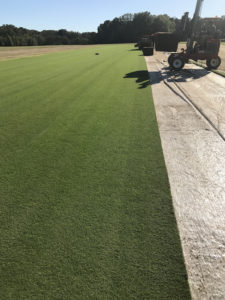
It’s a 10-hour drive from Carolina Green to the Eagles. Whether the shipping will involve 14 trucks or 30, each is making that trip. Each truck is assigned a number, from one through 14 or 30, as it is loaded. “We want those trucks to arrive and be unloaded in that order, so the first sod harvested is the first sod installed,” said Leonard. “In theory, that should happen based on the time each truck leaves the sod farm, but, because of all the potential variables, that doesn’t always happen. The logistics manager at the sod farm will have the names and cell phone numbers for each of the drivers and know which driver has which truck. I’ll be communicating with that logistics manager, who will let me know when each truck leaves the farm and relay any potential problems that come up in their communications with the drivers. The logistics manager also will provide the contact information for the dispatcher for the trucking company or companies. If there is an issue, I’ll reach out to the logistics manager first, who typically will be able to contact the driver or drivers and get things moving. If that doesn’t work for some reason, I’ll reach out to the dispatcher. We’re all working together to get the sod on the ground, so we can coordinate the installation.
“We work with the field managers at the other stadiums that use the same sod growers to lay out a plan that takes our varied schedules into consideration and helps give the grower a better handle on what he needs to do,” he added.
Logistics get even tougher when the schedules are tighter, with multiple events and game schedules overlapping and adverse weather conditions kicking in. Additional scheduling challenges come with working through weekends and around holidays, such as Labor Day, Thanksgiving, and Christmas.
“There needs to be continual communication and cooperation to determine the best time to start the harvesting and shipping process,” said Leonard. “Sod growers have developed strategies to keep the harvested sod fresher longer. Tuckahoe Turf Farms starts harvesting around 2:00 a.m., when temperatures are cooler, for summer shipments. In December, they time their harvesting to the daily temperature fluctuations, cutting the sod when it’s not frozen.”
There is no margin for error with the NFL field.
“Because of our partnership with the sod grower, we trust them to provide us with a safe field in excellent condition to play an NFL game,” said Leonard.
Suz Trusty is communications director for Trusty & Associates, a longtime supporter of sports field managers, and is co-editor of Turf News, the official publication of Turfgrass Producers International (TPI). TPI members are sod producers from around the world that grow natural grass for many different user groups including sports fields, golf courses, landscape contractors, retail outlets and homeowners, and those companies and individuals that provide services to them. This article originally appeared in the May/June issue of Turf News.
* Note: The 2020 NFL Field Managers Symposium was held prior to the progression of the coronavirus pandemic, so there was no discussion about what could happen if the NFL has a shortened season or no season or if the scheduled concerts are not held.

